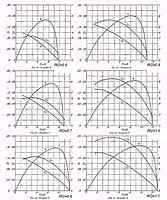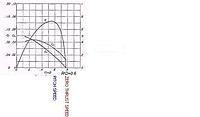|
|
|
|
|
How to calculate thrust, given RPM, prop pitch and prop diameter?
It's a question I've often needed the answer to. Without having to build a mechanism around a weighing scale to measure thrust from a prop, is there any way to calculate thrust by using just the prop diameter, pitch and RPM?
Thanks 
|
|
|
|
|
|
|
|
|
|
|
nope... its going to depend on air density, prop profile, prop blade area, the actual pitch of the prop (everyone has got different ways, or different pitch curves over the length of the prop).
You COULD calculate it, but you're going to need prop constants that are specific to THAT prop, which you'll need to get from real world data... So you're back to making a thrust rig... Easy way: Buy a 2x4, a scale, and some wire. Put the scale on the end of the 2x4 (or any skinny chunk of wood, at least skinnier than the scale). wrap the wire over the scale, and wrap it around the tail of your plane, and let it dangle from the scale. Then go full throttle and measure the change in the reading on the scale, boom, thrust. Or, if you have a fancy scale, you can zero it while the plane is hanging, and it'll just read thrust... |
|
|
|
|
|
|
|
|
http://www.lcrcc.net/thrust_calc.htm
or read the the thread on "How do YOU measure thrust" https://www.rcgroups.com/forums/showthread.php?t=286867 |
|
|
Last edited by Dr Kiwi; Oct 18, 2004 at 10:37 AM.
|
|
|
|
|
|
For props with Pitch/Diameter ratios less than 0.6 the formula for static thrust is
Thrust = P X D^3 X RPM^2 X 10^-10 oz. The constant 10^-10 will have to be changed dependent on the prop and manufacturer. GWS slowfly props would multiply the above by a factor of 1.0 For GWS HD props the factor would be approximately 0.75. For props which have P/D ratios greater than 0.6 the equation is not valid for static thrust. For these props the pitch used in the equation would be approximately the pitch for a P/D ratio of 0.6 and not the stated pitch. Edited below to correct for propeller constant variations: For the example shown above, at an RPM of 3660 the equation gives a thrust of 15.3 oz. for a 12 X 6 SF using a propeller constant of 1.1. A propeller constant of 1.0 gives a thrust of 13.9 Oz. |
|
|
Last edited by Martyn McKinney; Oct 18, 2004 at 03:11 PM.
|
|
|
|
|
|
Wow what an ingenious formula! I'll try that the next time I get some data .... Thanks Martin!
 Edit: Umm .... I don't get 15.3oz of thrust with the example above!  (6) x (12^3) x (3600^2) x (10^-10) = 13.88 oz .... |
|
|
Last edited by Hogster; Oct 18, 2004 at 01:23 PM.
|
|
|
|
|
|
OOPS !
The 15.3 Oz. resulted from using a prop constant of 1.1 for the GWS SF props. I decided that a constant of 1.0 was closer to reality. It would be worthwhile if someone can post some real numbers for GWS SF props to confirm the propeller constant. Thanks for bringing this to my attention. |
|
|
|
|
|
||
|
|
Quote:
 , but since it comes up as one of the top Google searches for "propeller thrust equation" I thought I'd respond, since many users may come across this thread and have your same question. I also had your same question, so I came up with an equation for it. I compared my equation to the (Thrust = P X D^3 X RPM^2 X 10^-10 oz) equation, and I found mine to perform a bit better overall. Additionally, the equation I came up with accounts for static *and* dynamic thrust, so you can see how the thrust will decrease as your airspeed increases. , but since it comes up as one of the top Google searches for "propeller thrust equation" I thought I'd respond, since many users may come across this thread and have your same question. I also had your same question, so I came up with an equation for it. I compared my equation to the (Thrust = P X D^3 X RPM^2 X 10^-10 oz) equation, and I found mine to perform a bit better overall. Additionally, the equation I came up with accounts for static *and* dynamic thrust, so you can see how the thrust will decrease as your airspeed increases.Here is the simplified version of my equation: F = 4.3924e-8*RPM*d^3.5/sqrt(pitch)*(4.23333e-4*RPM*pitch – Vac). F is thrust in Newtons, RPM is rotations per minute, d is prop. diameter in inches, pitch is prop. pitch in inches, Vac is aircraft airspeed in m/s. If you want thrust in other units: to convert newtons to grams, multiply newtons by 1000/9.81. To then convert grams to ounces, multiply grams by 0.035274. To convert ounces to pounds, divide ounces by 16. The generics of the equation can be found here, including an Excel spreadsheet to make your life easier, and the equation above is shown here in a more visually appealing form: http://www.electricrcaircraftguy.com...-equation.html The full derivation of the equation begins with Newton’s laws, and is shown here: http://www.electricrcaircraftguy.com...ackground.html I hope this is useful to many people, as it is very useful to me. |
|
|
|
Last edited by panther3001; Jun 13, 2015 at 07:19 AM.
|
|
|
|
|
|
|
The equation can be tailored to fit any size propeller. However, I determined the empirical constants in this equation using data from propellers ranging from 5x5 to 17x8 in., so that's the size range this particular equation with these empirical constants applies to.
|
|
|
|
|
|
||
|
|
Quote:
This implies that if Flying Speed is equal to Pitch Speed that the thrust is equal to Zero. This is not correct. At Pitch Speed (RPM X Pitch) the angle of attack along the entire blade is zero degrees which has the best Lift-Drag ratio. Flat-bottomed airfoils (propellers) still generate thrust at negative angles of attack up until Zero Thrust Speed. The Zero Thrust Speed occurs at airspeeds up to 40% higher than Geometric Pitch Speed depending on the Pitch to Diameter ratio of the prop. At Pitch Speed there is still significant thrust available and is the propeller's most efficient operating point. On the Advance curves, Pitch Speed occurs at an Advance equal to the P/D ratio. Zero Thrust Speed occurs at an Advance equal to P/D + 0.2. |
|
|
|
Last edited by Martyn McKinney; Sep 21, 2014 at 05:48 PM.
|
|
|
|
||
|
|
Quote:
I appreciate this info. In regards to the following lines, I've known what you say to be correct for a long time now (probably a couple years): "In your equation, the last bracketed terms are (4.23333e-4*RPM*pitch – Vac) which I interpret as being (Pitch Speed - Flying Speed). This implies that if Flying Speed is equal to Pitch Speed that the thrust is equal to Zero. This is not correct. At Pitch Speed (RPM X Pitch) the angle of attack along the entire blade is zero degrees which has the best Lift-Drag ratio. Flat-bottomed [more generally speaking: cambered] airfoils (propellers) still generate thrust at negative angles of attack up until Zero Thrust Speed." What I didn't know, however, are the lines after that (in red above), so that is very valuable info. I spent nearly all of my time on that equation focusing on getting the static thrust right for any given prop at any given RPM. I didn't, however, spend much time on the dynamic thrust part since I only had one single data point (wind tunnel data, see right-side of Fig. 1 here) to compare to, and I didn't have a book solution to know where zero thrust occurred. Nevertheless, I knew it was at a negative angle of attack, but I used pitch speed to start just so I'd have a rough initial guess. Where did you get those plots, by the way? I will def. need them to correct and improve my equation, and so I can include them on my site and properly cite where they came from. I'd like to read those pages surrounding the plots for sure too. |
|
|
|
Last edited by panther3001; Sep 21, 2014 at 07:54 PM.
|
|
|
|
|
|
|
NACA Technical Report TR-237
http://naca.central.cranfield.ac.uk/...report-237.pdf In your equation you could multiply the Pitch Speed term by a factor to get Zero Thrust Speed. Zero Thrust Speed = Pitch Speed X (P/D+0.2)/(P/D) Just another comment: At Zero Thrust Speed the motor will be very lightly loaded. Because of this a reasonable estimate of its RPM is simply: RPM = Battery Voltage X Kv. This RPM could be significantly different than the static RPM depending on the efficiency of the motor. It should also be possible to include an estimate of the varying RPM information into your formula. |
|
|
Last edited by Martyn McKinney; Sep 21, 2014 at 08:00 PM.
|
|
|
||
|
|
Quote:
|
|
|
|
||
«
Previous Thread
|
Next Thread
»
| Thread Tools | |
| Similar Threads | |||||
| Category | Thread | Thread Starter | Forum | Replies | Last Post |
| Discussion | I know the RPM's and the prop size, how to calculate thrust? | Fiasco | Electric Power Systems | 17 | Mar 31, 2015 09:02 PM |
| Calculate Static thrust by RPM and prop diameter and pitch? | Xnaron | Electric Power Systems | 7 | Mar 22, 2004 10:59 PM | |
| Can anybody with Ecalc help me? How much thrust will a 5x5 prop make, at 19,000 rpm? | I FO nut | Electric Plane Talk | 25 | Jul 01, 2003 09:26 AM | |





